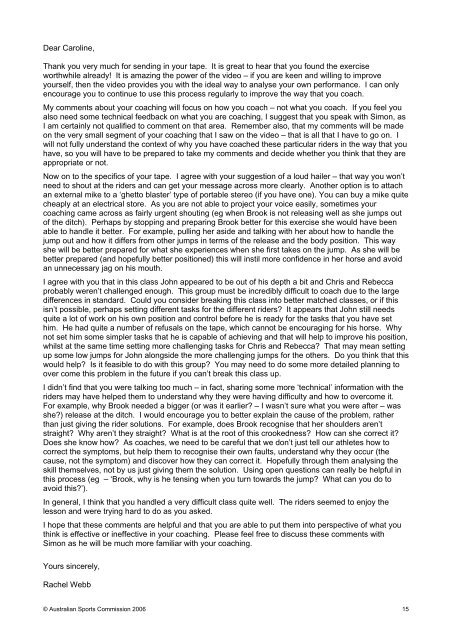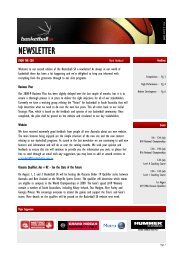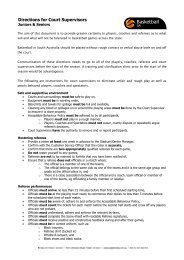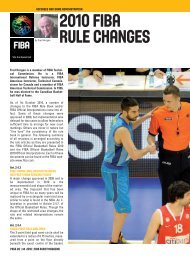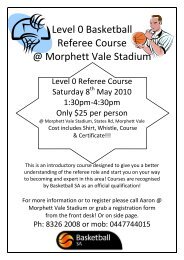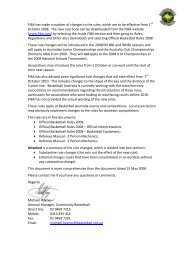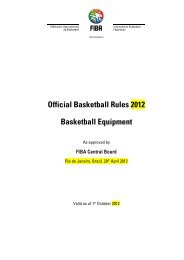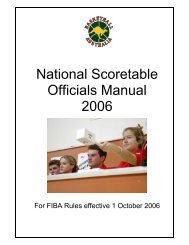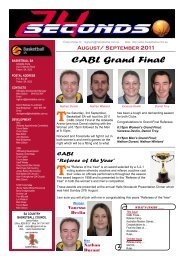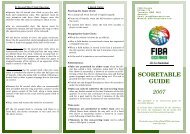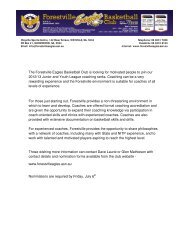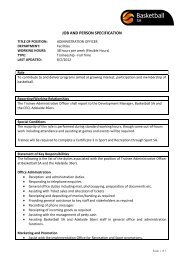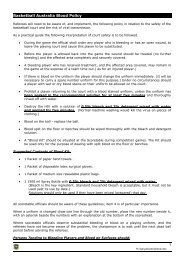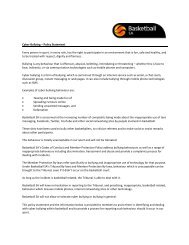Mentor Training â Sample Program - Basketball SA
Mentor Training â Sample Program - Basketball SA
Mentor Training â Sample Program - Basketball SA
- No tags were found...
You also want an ePaper? Increase the reach of your titles
YUMPU automatically turns print PDFs into web optimized ePapers that Google loves.
Dear Caroline,Thank you very much for sending in your tape. It is great to hear that you found the exerciseworthwhile already! It is amazing the power of the video – if you are keen and willing to improveyourself, then the video provides you with the ideal way to analyse your own performance. I can onlyencourage you to continue to use this process regularly to improve the way that you coach.My comments about your coaching will focus on how you coach – not what you coach. If you feel youalso need some technical feedback on what you are coaching, I suggest that you speak with Simon, asI am certainly not qualified to comment on that area. Remember also, that my comments will be madeon the very small segment of your coaching that I saw on the video – that is all that I have to go on. Iwill not fully understand the context of why you have coached these particular riders in the way that youhave, so you will have to be prepared to take my comments and decide whether you think that they areappropriate or not.Now on to the specifics of your tape. I agree with your suggestion of a loud hailer – that way you won’tneed to shout at the riders and can get your message across more clearly. Another option is to attachan external mike to a ‘ghetto blaster’ type of portable stereo (if you have one). You can buy a mike quitecheaply at an electrical store. As you are not able to project your voice easily, sometimes yourcoaching came across as fairly urgent shouting (eg when Brook is not releasing well as she jumps outof the ditch). Perhaps by stopping and preparing Brook better for this exercise she would have beenable to handle it better. For example, pulling her aside and talking with her about how to handle thejump out and how it differs from other jumps in terms of the release and the body position. This wayshe will be better prepared for what she experiences when she first takes on the jump. As she will bebetter prepared (and hopefully better positioned) this will instil more confidence in her horse and avoidan unnecessary jag on his mouth.I agree with you that in this class John appeared to be out of his depth a bit and Chris and Rebeccaprobably weren’t challenged enough. This group must be incredibly difficult to coach due to the largedifferences in standard. Could you consider breaking this class into better matched classes, or if thisisn’t possible, perhaps setting different tasks for the different riders? It appears that John still needsquite a lot of work on his own position and control before he is ready for the tasks that you have sethim. He had quite a number of refusals on the tape, which cannot be encouraging for his horse. Whynot set him some simpler tasks that he is capable of achieving and that will help to improve his position,whilst at the same time setting more challenging tasks for Chris and Rebecca? That may mean settingup some low jumps for John alongside the more challenging jumps for the others. Do you think that thiswould help? Is it feasible to do with this group? You may need to do some more detailed planning toover come this problem in the future if you can’t break this class up.I didn’t find that you were talking too much – in fact, sharing some more ‘technical’ information with theriders may have helped them to understand why they were having difficulty and how to overcome it.For example, why Brook needed a bigger (or was it earlier? – I wasn’t sure what you were after – wasshe?) release at the ditch. I would encourage you to better explain the cause of the problem, ratherthan just giving the rider solutions. For example, does Brook recognise that her shoulders aren’tstraight? Why aren’t they straight? What is at the root of this crookedness? How can she correct it?Does she know how? As coaches, we need to be careful that we don’t just tell our athletes how tocorrect the symptoms, but help them to recognise their own faults, understand why they occur (thecause, not the symptom) and discover how they can correct it. Hopefully through them analysing theskill themselves, not by us just giving them the solution. Using open questions can really be helpful inthis process (eg – ‘Brook, why is he tensing when you turn towards the jump? What can you do toavoid this?’).In general, I think that you handled a very difficult class quite well. The riders seemed to enjoy thelesson and were trying hard to do as you asked.I hope that these comments are helpful and that you are able to put them into perspective of what youthink is effective or ineffective in your coaching. Please feel free to discuss these comments withSimon as he will be much more familiar with your coaching.Yours sincerely,Rachel Webb© Australian Sports Commission 2006 15


